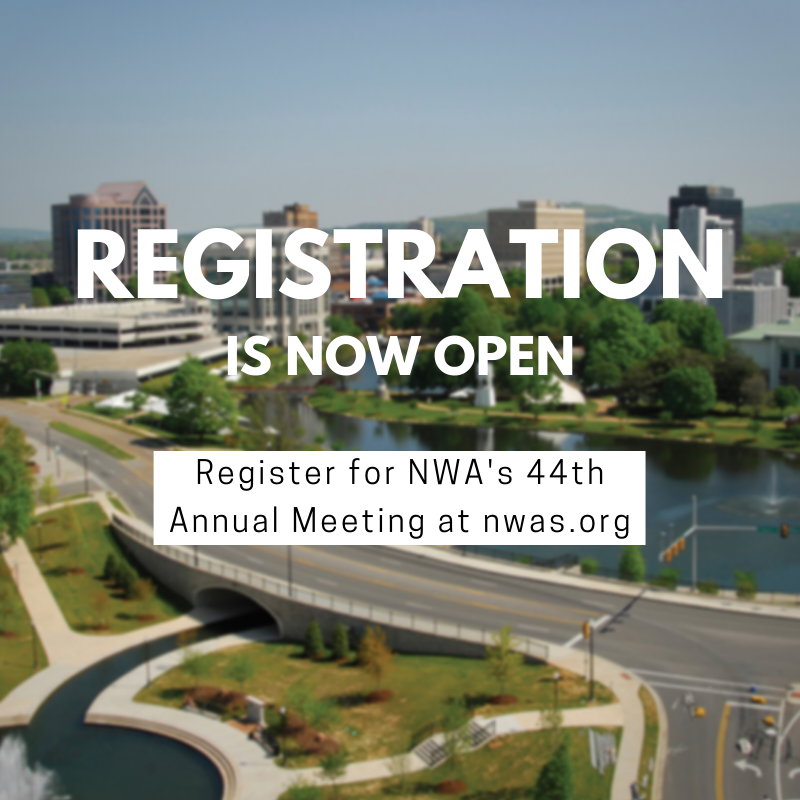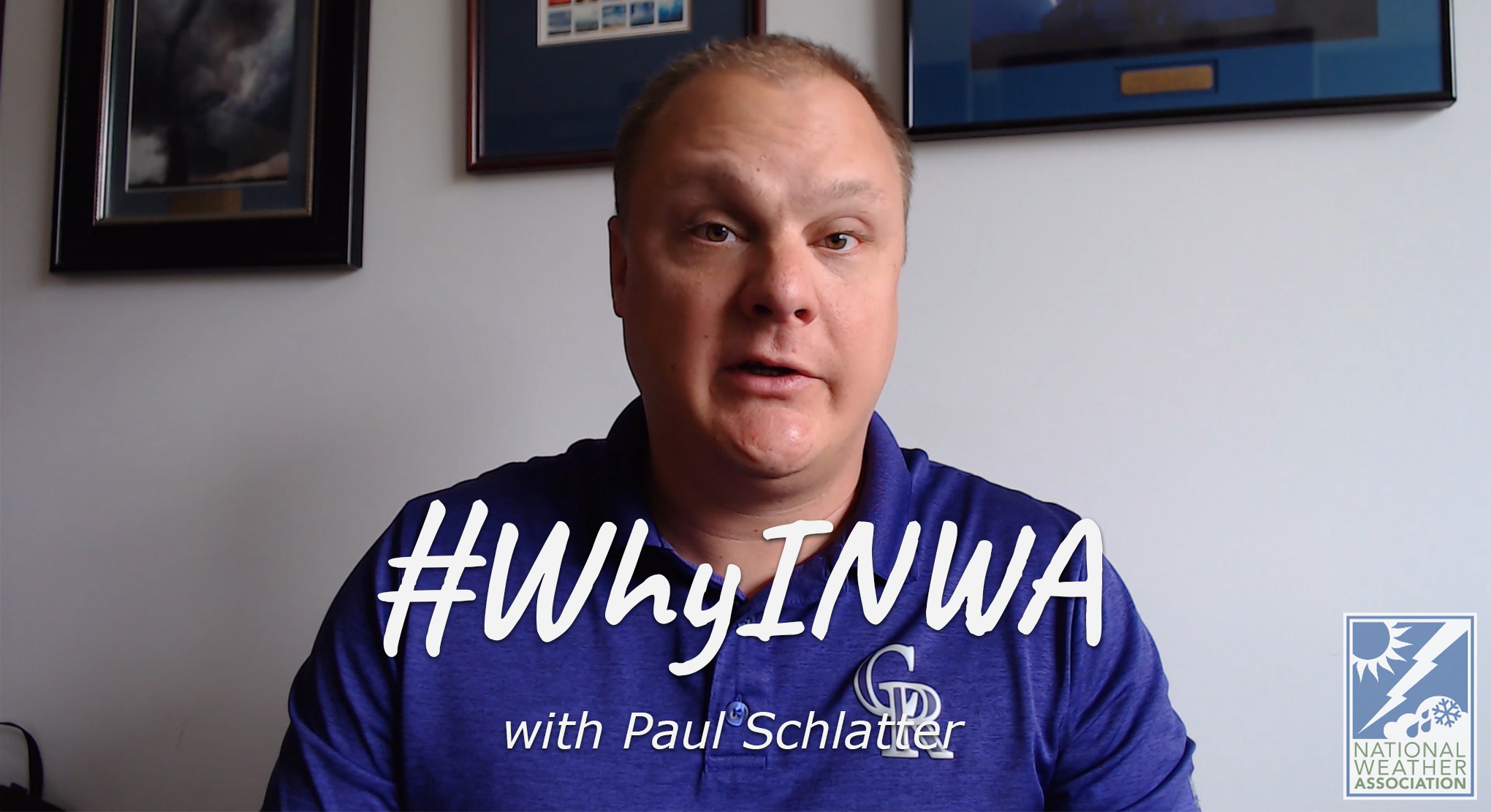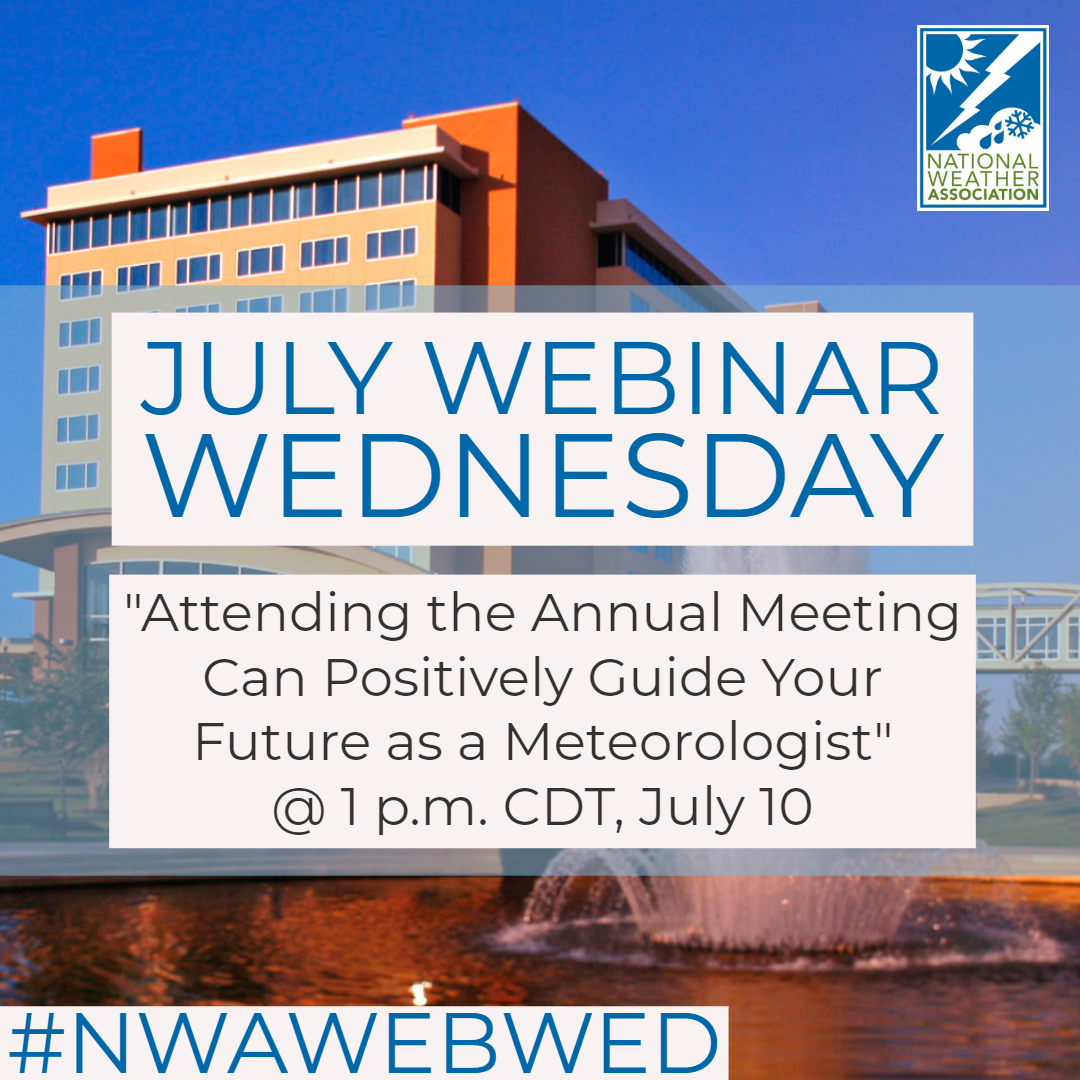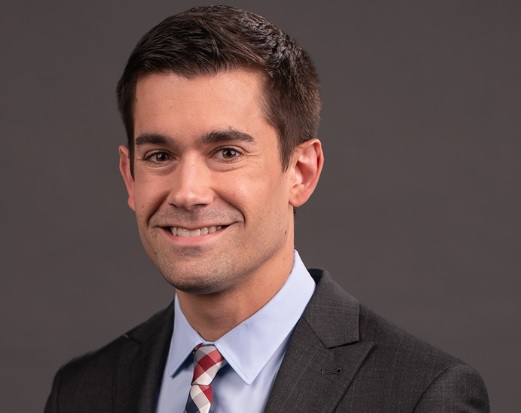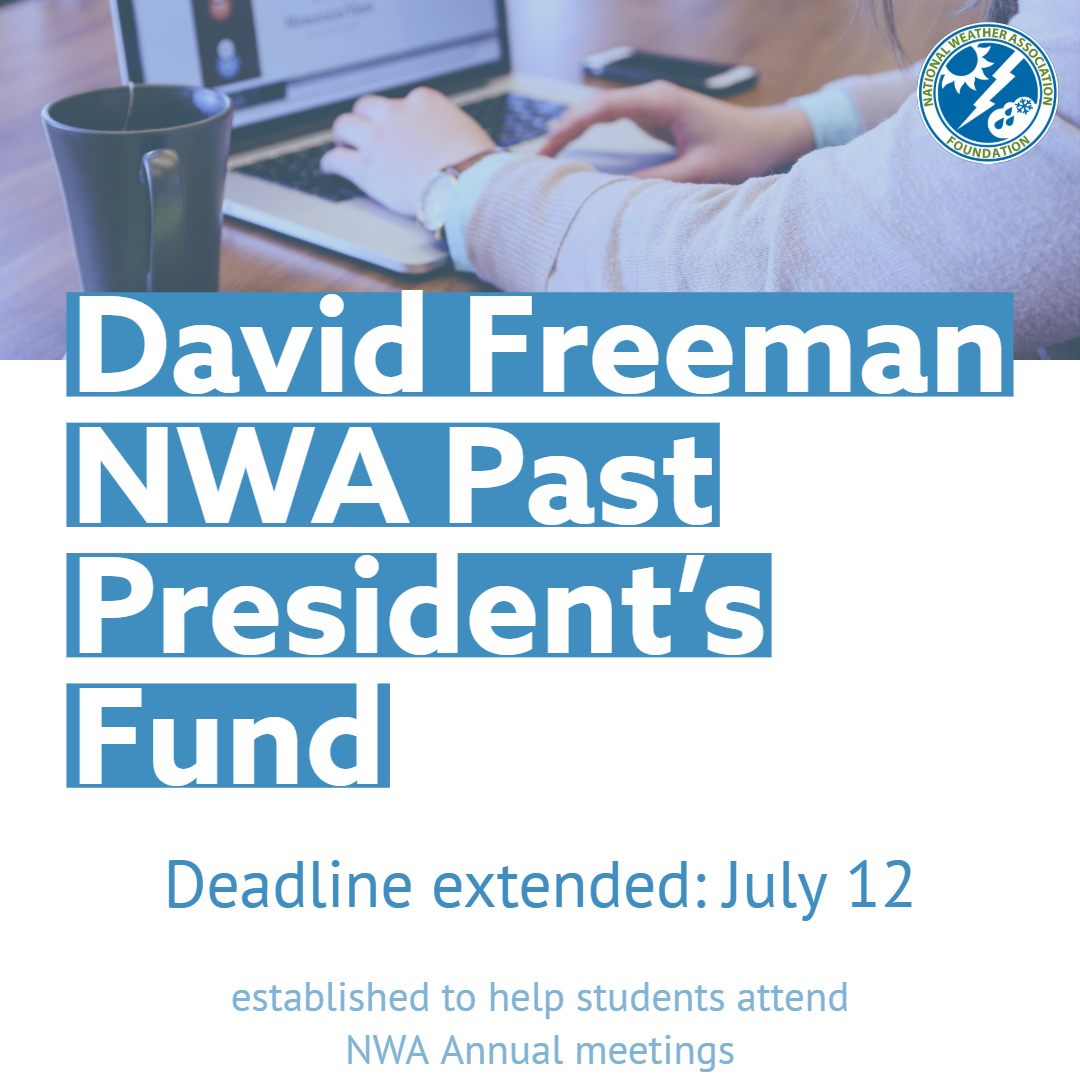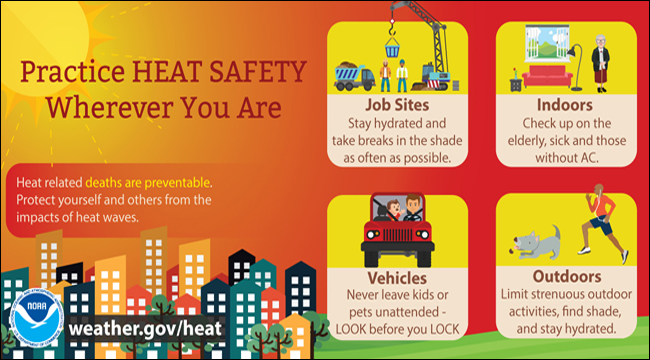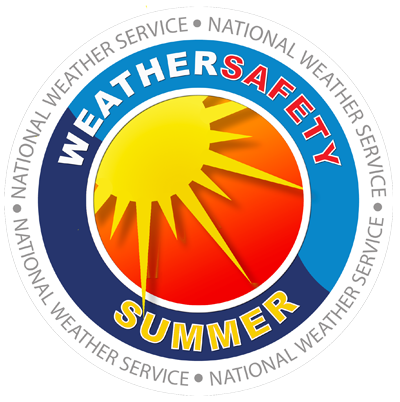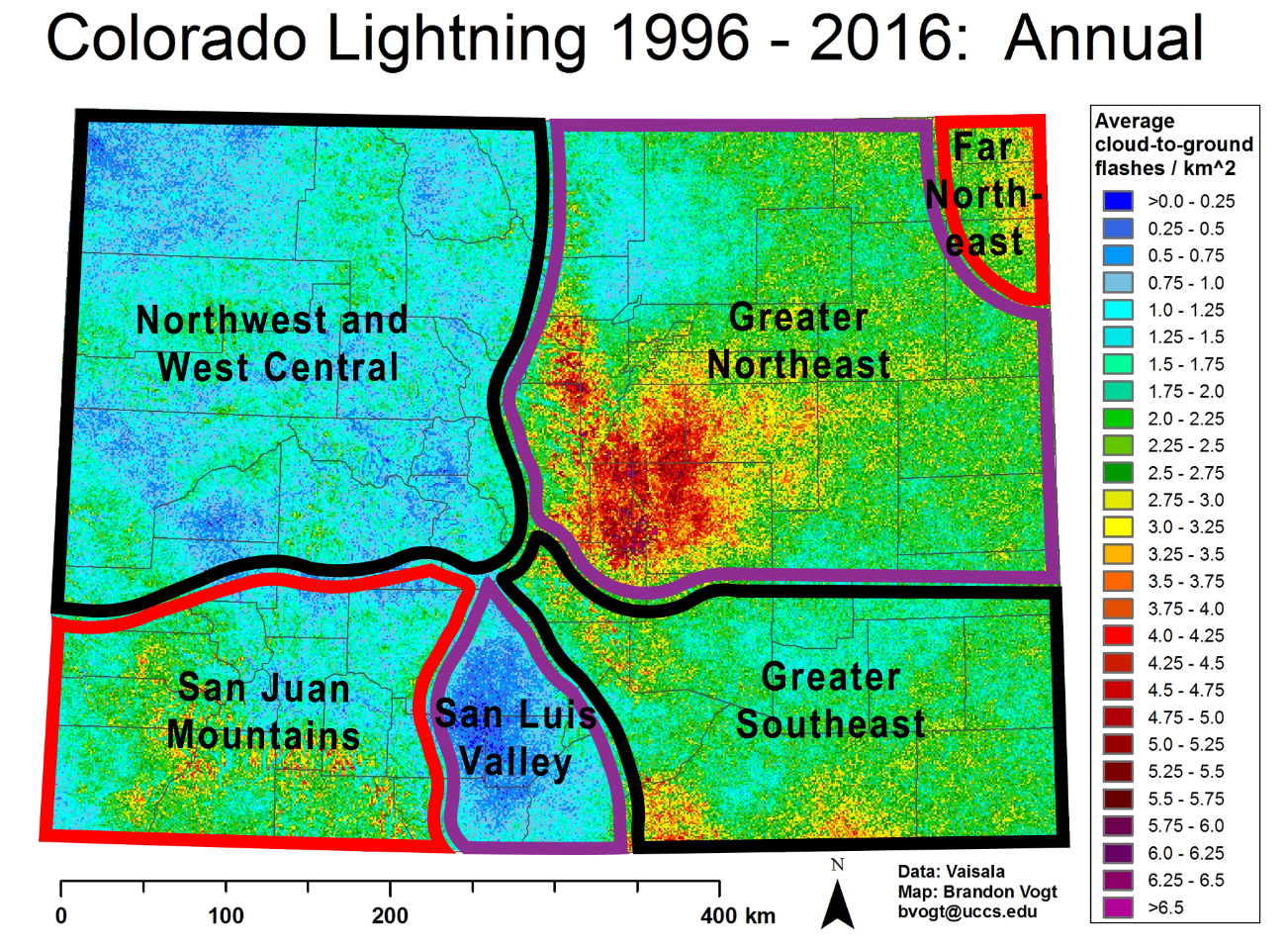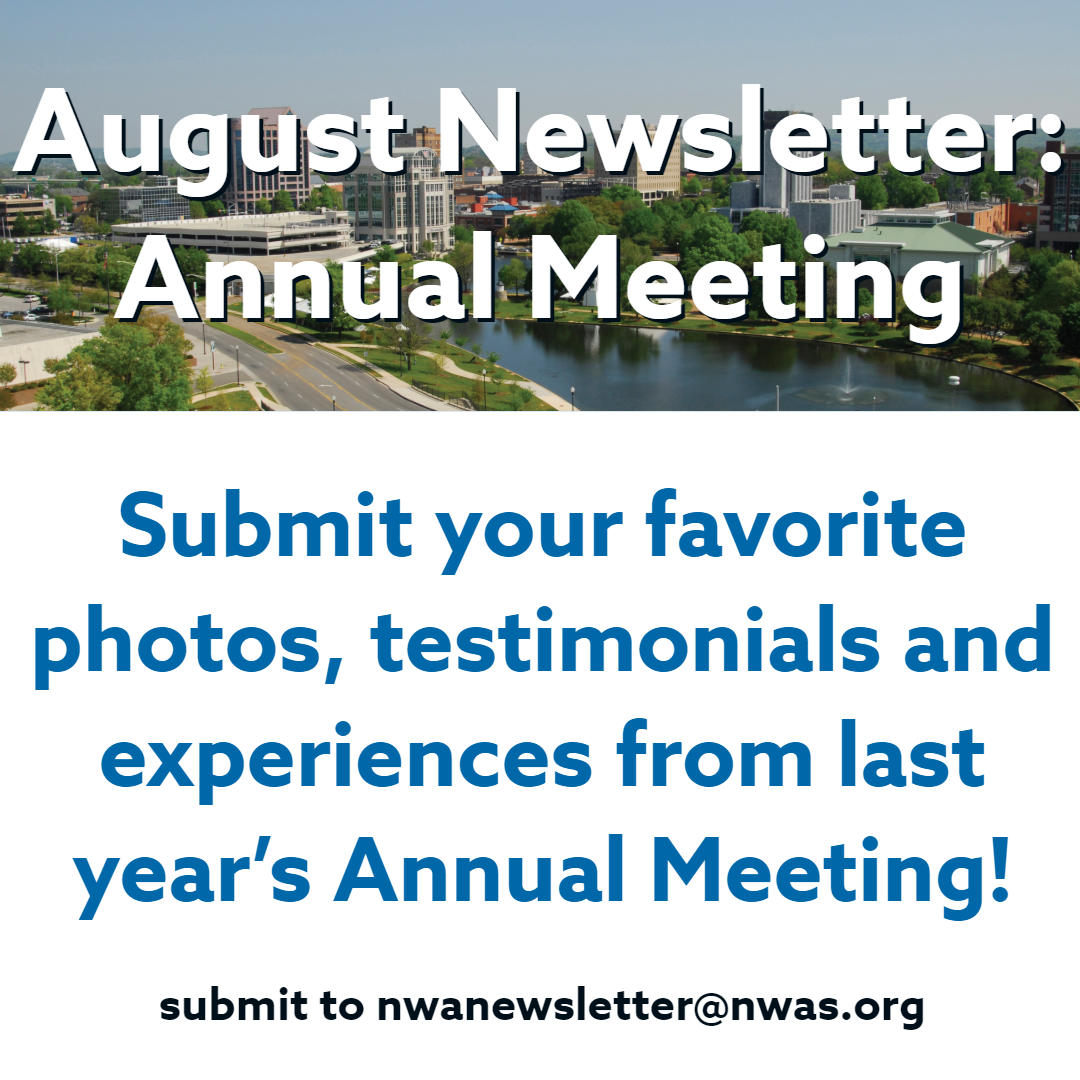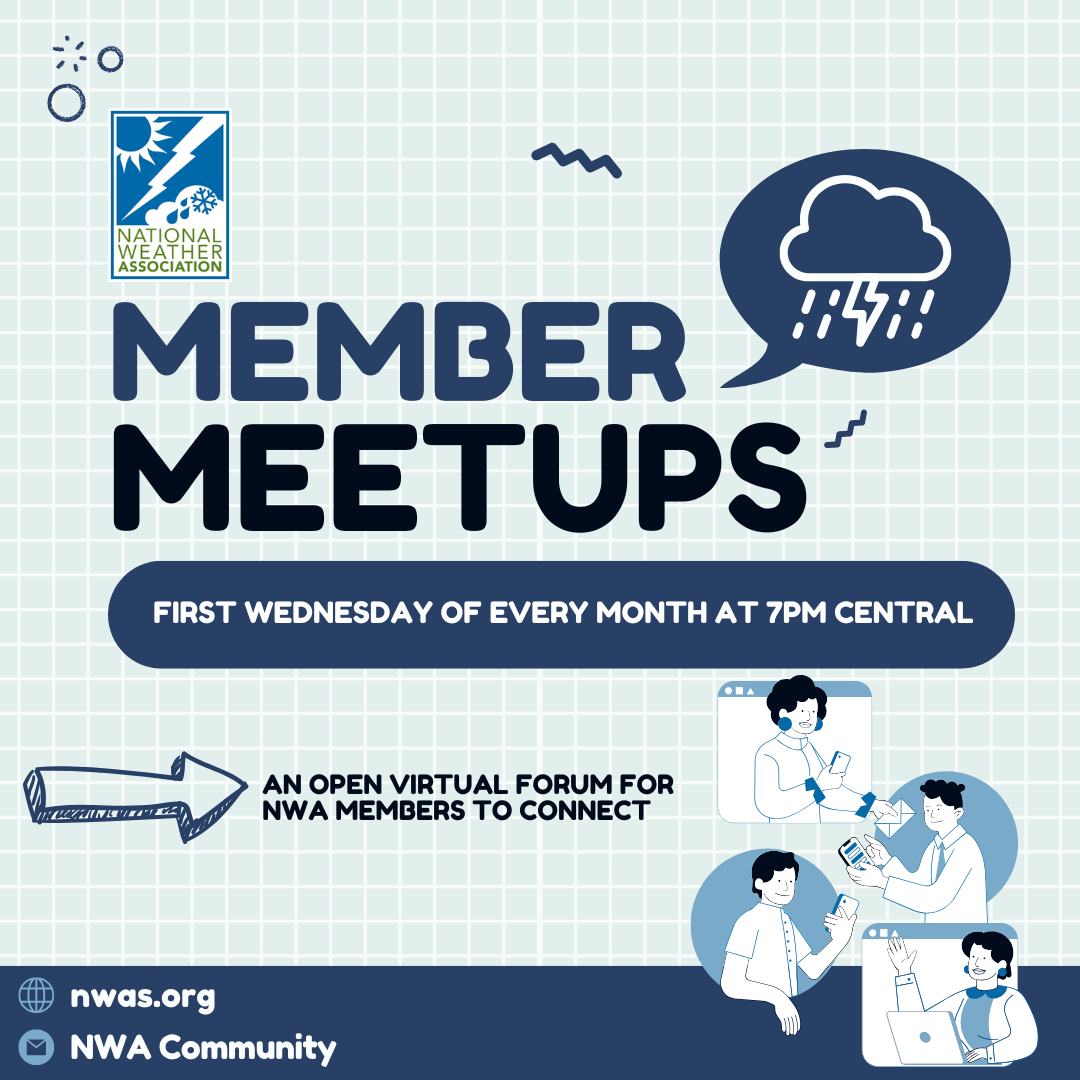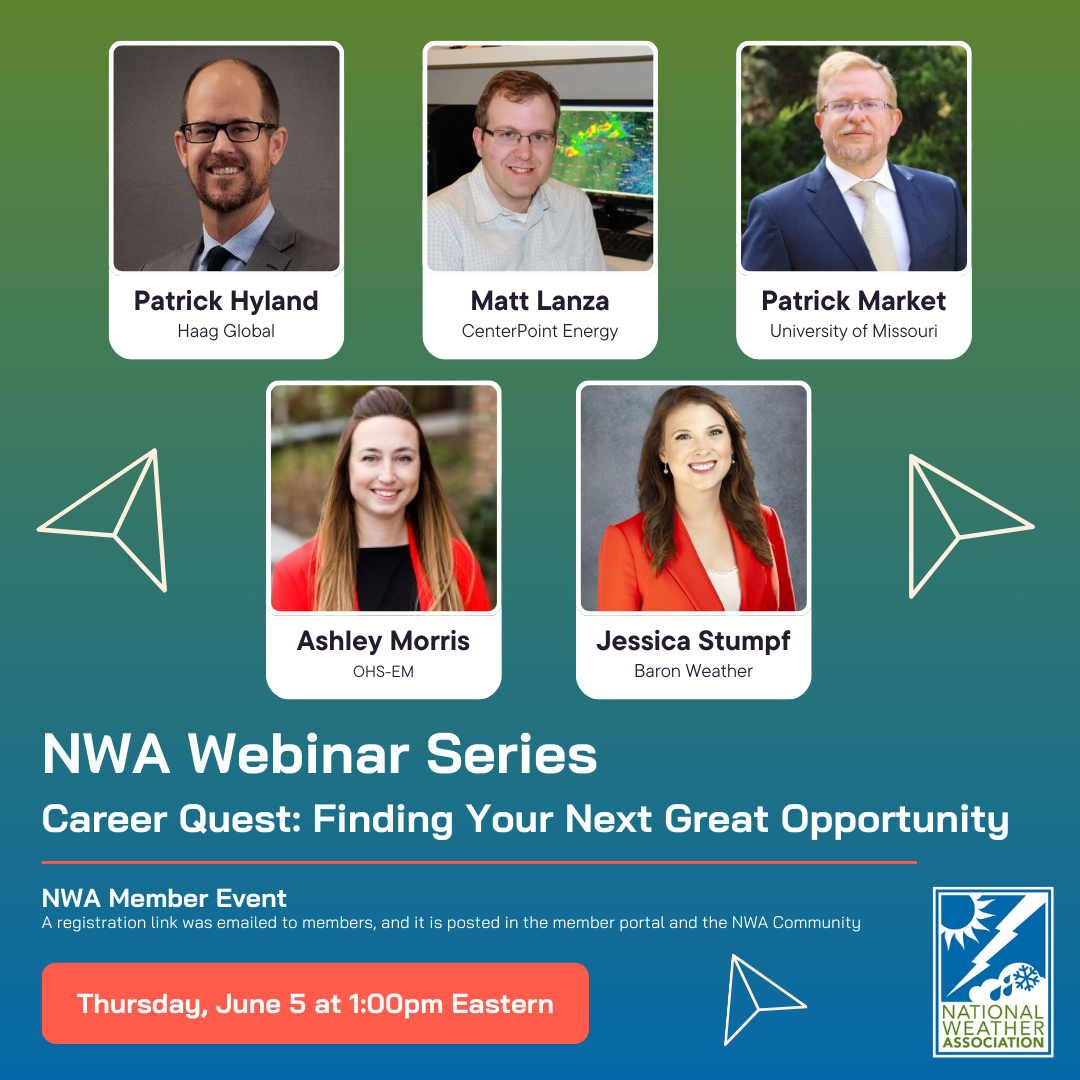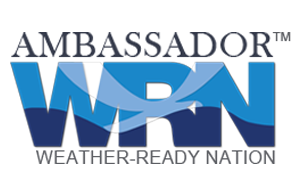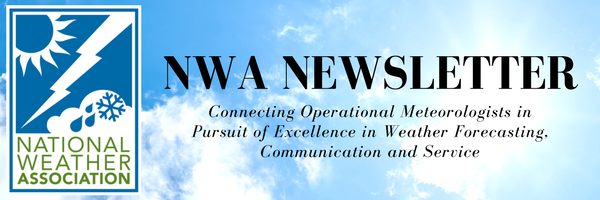 NWA July 2019 Newsletter
Issue 19 - 7
NWA President Paul Schlatter
This month’s newsletter is focused on heat. For a few of us, myself included, that is an ironic topic given that it snowed heavily on the summer solstice 20 miles west of me in the mountains of Colorado. It was chilly enough in Boulder to need a sweatshirt in the middle of the day! For just about everyone else reading this newsletter, the heat of summer is already upon us, and I hope you enjoy the articles about heat in this newsletter. I want to use July’s message to highlight how “It takes a village” to achieve success in two separate but important things relevant to all of us. The first event occurs at the NWA Annual Meeting in Huntsville, Alabama, on Saturday, September 7. Weather Ready Fest is a massive outreach event every year the Saturday before the Annual Meeting. This year it runs from 10:00 a.m. through 4:00 p.m. Thousands of people have attended these events in past years, and no doubt thousands will also attend this year because the venue is the University of Alabama-Huntsville. Weather Ready Fest is all about preparedness and resiliency, with the goal of sharing knowledge with all attendees, young and old. It will include hands on activities related to weather safety, well-known guest speakers, and many local/national organizations and companies will be on hand with booths focusing on preparedness and resilience. There will even be outdoor water-themed activities to cool off in the Alabama heat and humidity. The NWA Foundation is in charge of organizing this event each year, and it is a massive undertaking. It takes a village to make Weather Ready Fest a success, and the team needs YOUR help. If you are interested in volunteering, please fill out the Google Docs form. The second example of “It takes a village” refers to the efforts of the integrated warning team (IWT) to save lives in the face of extreme weather, most recently during the tornado outbreaks May 2019. This was an active month for tornadoes in the U.S., with much above normal numbers of tornadoes and several violent tornadoes moving through populated areas like Lawrence, Kansas, to western parts of Kansas City metropolitan area, Jefferson City, Missouri, and Dayton, Ohio, just to name a few. The loss of life in these tornadoes was extremely low. While technological advances like wireless emergency alerts have made leaps and bounds in getting the warnings to the masses over the past eight to ten years, I also believe the efforts made by “the village,” i.e. the IWT, have made substantial advances towards saving lives from tornadoes.
Saving lives via “It takes a village” begins with accurate forecasts days in advance. Throughout May, the NWS Storm Prediction Center generated convective outlooks for severe weather several days in advance. At the same time, local NWS offices, private sector companies, and broadcast meteorologists personalized the threat messaging, helping people in their areas (or customer base for private companies) understand what to expect by providing more details on potential timing and impacts. Social science research, conducted by many reading this newsletter, informs effective messaging during the outlook/watch and warning phases, making it as understandable and actionable as possible. For example, the NWS was able to identify the possibility of a violent system six days in advance that spawned an EF-4 tornado with a path length over 30 miles in Kansas, and the IWT effectively messaged the potential impacts every day leading up to the tornado. Four days prior to the event, the NWS identified this as an enhanced risk. Three days in advance, the Kansas City area was placed under a “hatched area” for “significant severe weather potential,”. The day of the event the NWS led countless briefings with emergency management officials across the region, broadcast meteorologists constantly highlighted and personalized the risks to millions of viewers and online users, and the private sector provided tailored impact forecasts for their customers. Four hours before the violent tornado touched down in Douglas County, Kansas, the NWS issued a tornado watch. As I just described, the days of preparation and messaging prior to the tornado warning was critical and involved the entire village. One of the interesting things that occurred with the Kansas EF-4 tornado in late May that I have never heard of before was that highway construction materials were cleared from the roads in eastern Kansas before the first storms fired. All the materials were cleared! This allowed for better access to damaged areas and eliminated the possibility of loose construction materials impacting people or structures in the tornadic environment. This is only possible if the entire village is on the same page, communicating threats and providing accurate timing and potential impacts with days of lead time. As storms developed, the IWT made sure tornado warnings reached as many people as possible, and no lives were lost despite the tornado reaching EF-4 intensity. I believe in miracles, but this was no miracle. I don’t want us to take these efforts for granted because it is truly amazing when the system, including the people, works as intended. It takes a village to prepare the people and customers we serve to take action when severe weather threatens. We should all be proud of the way we work together to save lives, and the tornadoes in May 2019 were an impressive example of this. Let’s never stop striving to improve what we do. Overview of the 1995 Chicago Killer Heat Wave A potent combination of heat and moisture created lethal conditions throughout Chicagoland during the summer of 1995, especially from July 11 to 17. Despite having some anticipation of record high temperatures, Chicagoans were ill-equipped to combat the mid-July heat wave. The “American Journal of Public Health” estimates that 739 lives were claimed by the oppressive heat. The lessons learned from this tragedy revolutionized how the National Weather Service (NWS) in Chicago communicates hazardous weather to city officials as well as how the city prepares for and responds to hazards. In fact, this partnership between the city and NWS Chicago remains one of the premier examples of the Weather Ready Nation initiative, which stresses that a forecast is only valuable when users understand it and respond appropriately. Meteorological Synopsis. A very warm, moist air mass had set up over the Midwest on July 12, 1995. The high moisture content was exacerbated due to evapotranspiration from crops across the Corn Belt. An upper-level anticyclone funneled warm air into the region while simultaneously forcing it to stay near the ground. The sum of all these factors resulted in heat indices in excess of 100 F between July 12 and 16, overnight low temperatures that were near normal daytime high temperatures for this time of year, and an all-time record high temperature of 106 F at Midway Airport on July 13. Then and Now—What We Learned. Residents’ social isolation for fear of crime, inexperienced city officials, and a general lack of respect for heat led to the tragic outcome. In the wake of the disaster, the way Chicago planned for emergencies, even beyond heat-related events, was completely overhauled. The NWS and city drafted Chicago-specific heat warning criteria that included sustained heat parameters for one, two, or three days. Along with these new criteria came new procedures for how to manage extreme heat and other crises that may affect Chicago. A direct hotline was also established between the NWS and the Chicago Office of Emergency Management and Communications (OEMC). These strides towards a preventative approach to public safety are used today and reviewed often so that they are up to date. Summary. NWS Chicago works closely with the city in a variety of weather conditions and situations. Though the 1995 heat wave shook the city to its core, examples of the lessons learned and the newfound commitment to public safety are present today. These include relatively limited impacts from the infamous 2011 Groundhog Day blizzard, minimal loss of life during the 2019 record cold outbreak, and recent large-scale event evacuations (such as Lollapalooza) due to inclement weather that were executed without incident. While the heat wave tragedy was brought about by significant heat and moisture and exacerbated by a lack of preparedness, great strides to improve preparedness and communication were made immediately following the event. The NWS and the City of Chicago continue to work together closely as part of a large network of preventative measures designed to keep Chicagoland safe. Janice Bunting, NWA Executive Director
Tanya Schoor has returned to her Member Services Specialist position here at HQ in Norman, Oklahoma. Tanya said she's excited to be back working with all members and Seal Holders.
"Feel free to reach out to me if you need any assistance, I'm here to help!" she said. Welcome back, Tanya!
You can reach Tanya at [email protected]. 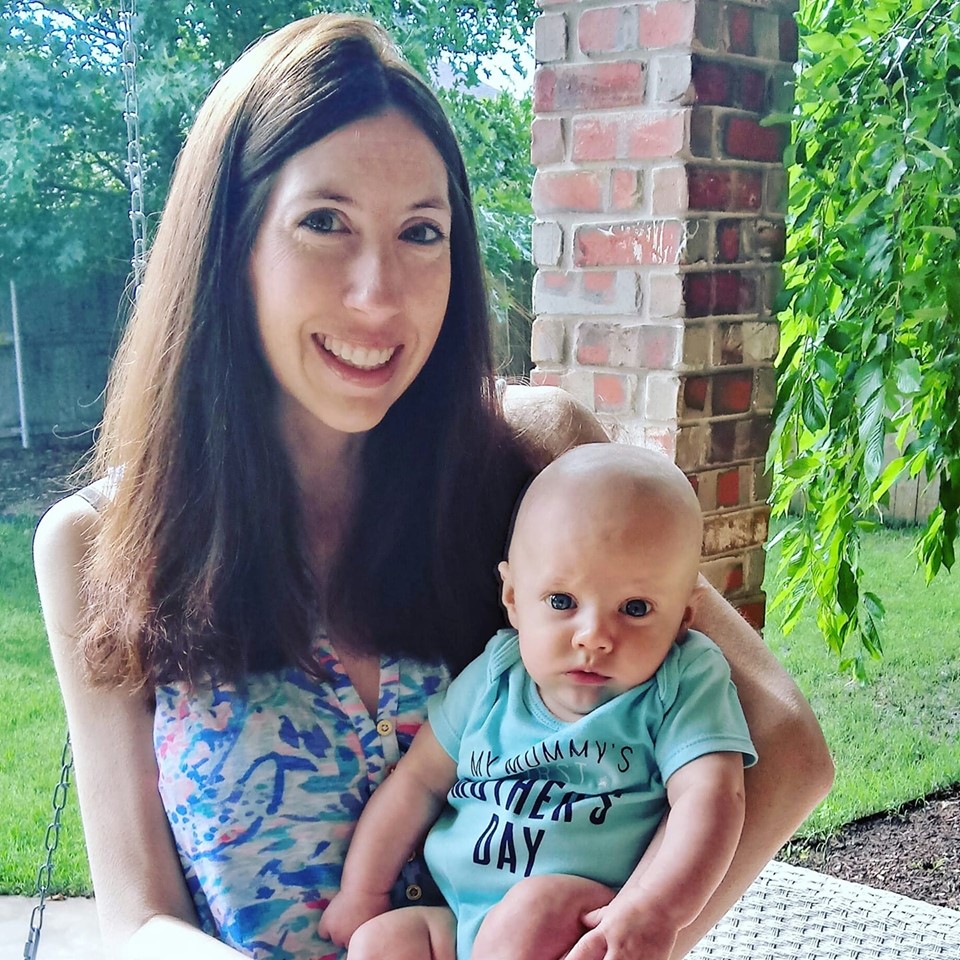 Save Our Kids-Let's Admit We're Human Summer is here, and my heart is breaking again. In the past few days more children have died of heat stroke after being left alone in hot cars. So far this year 15 kids have died, and we’re not yet into our hottest months. Like in past summers, I’m asking myself, “What can be done?” I’m not the only one asking this question. Since 1998, 810 children have died in this country after being left in automobiles whose interiors heated up to 120 degrees or hotter in a matter of minutes. Last year saw 52 deaths, the most ever recorded in one year. Click the infographic to download and share! Update on Former Executive Director Steve Harned On May 1 Steve Harned, founder and president of Atlantic States Weather, Inc. (ASWeather), sold his company to Thomas (T.C.) Moore of Raleigh, North Carolina. Steve, an NWA charter member, formed ASWeather in 2004. With a B.S. in meteorology from Florida State University, his professional career has spanned almost half a century including 36 years with the NWS and 25 years serving as a weather officer in the U.S. Naval Reserves. As an NWA member, Steve held the office of NWA national president in 1991 and served as NWA Executive Director from 2007 to 2014. Steve will continue to be associated with the firm in an advisory and resource role and will complete work on any assignments he began prior to the sale. He is also looking forward to having more time for golf!
T.C. is a retired U.S. Air Force (USAF) Lieutenant Colonel, having served over 22 years active duty as a weather officer, and holds both a B.S. in meteorology and an M.S. in atmospheric science from North Carolina State University. He is an NWA member and volunteers as a lead member of the Weather Watch Team for eastern North Carolina Red Cross disaster preparedness, response, and recovery. T.C. brings a deep record of meteorological understanding, demonstrated leadership skills, and outstanding interpersonal abilities to ASWeather, and will demonstrate these skills as President of the firm. NWA Newsletter Editorial Board
The NWA 44th Annual Meeting in Huntsville, Alabama, September 7-12, is fast-approaching. Early Bird rates for registration will apply until July 31 — learn more here.
The High Plains AMS/NWA Chapter Minutes The AMS/NWA High Plains Chapter held a virtual meeting via phone on Tuesday, June 11 at 1:30 p.m. with 12 chapter members. The first item discussed was the new design of our webpage. If you haven’t seen it yet, check it out at www.highplains-amsnwa.org. The next item discussed was elevating the webmaster to chapter officer status. Elizabeth Vickery was voted in as webmaster and is a new chapter officer. Also, Merl Heinlein was voted in as the new chapter treasurer. There was also a discussion about designing a new logo for the chapter as well as opening a store to sell High Plains Chapter items. An email will be sent to the members asking them to vote for the new logo and online store. Brian Warren from NWS Goodland then gave an update about the High Plains Conference for August 6-8. Keynote speakers have been verified and, as of now, Chris Strager and Louis Uccellini also plan to attend. There will be a working lunch on Wednesday, August 7, with a fun leadership activity planned. A tabletop exercise is scheduled for Tuesday night at the NWS Goodland office with an informal get together afterwards. A panel discussion about collaboration is planned during the conference. The panel will consist of someone from the Weather Prediction Center, Chris Strager, and other NWS employees. The organizers would like to have at least one person from each office as a part of this panel, so if anyone is interested in joining please let Brian know. Last, a reminder was given to submit dues for the chapter this year. Dues are once again $15 and can be given to the chapter officer at your office. There was no presentation during this meeting. The meeting was adjourned at 1:45 p.m. The next High Plains Chapter meeting is expected to be in a couple of months.
We Want You for #WhyINWA With our recent launch of #WhyINWA, featuring NWA President Paul Schlatter, we're looking for more participants to talk about their careers, passions and interests in meteorology, and how the NWA has impacted them. Submit your NWA Member peers, or yourself, on this form to be featured on our next #WhyINWA. And don't forget to chime in on Twitter using '#WhyINWA'!
COMET Quarterly Announcement Summer 2019 Greetings from Boulder, Colorado! Below you will find links to COMET’s latest publications on MetEd. Over the past three months, we published four new lessons providing training on the Community Earth System Model (CESM), convection-allowing models (CAMs), impact-based forecasting, and wind-related instruments and measurements. We also published three new lessons in Spanish (two on instrumentation, and an introductory lesson on the oceans), and a new French lesson on interpreting satellite imagery. New Lessons in English Convection-allowing Models (CAMs): Winter Applications Communicating Risk: The Impact-based Forecast and Warning Services Approach Instrumentation and Measurement of Wind New Lessons in Spanish Los instrumentos y la medición de la humedad atmosférica Meteorología básica: introducción a los océanos terrestres Características de funcionamiento de los instrumentos meteorológicos New Lesson in French Interprétation de base de l’imagerie satellitaire Currently, these materials are freely available to everyone, courtesy of our primary sponsors: NOAA's NWS, NESDIS and National Ocean Service programs, EUMETSAT, the Naval Meteorology and Oceanography Command, the Meteorological Service of Canada, Bureau of Meteorology, the U.S. Army Corps of Engineers, and the Department of the Interior Bureau of Reclamation. Seeking Volunteers for the NWA Webinar Team Are you interested in discussing meteorological science and service in support of the NWA mission? Here's your chance. The NWA Webinar Team is seeking volunteers to serve as hosts for NWA Webinar Wednesdays. The time commitment will be at least two webinars per year with roughly three to five hours per webinar to help plan, review material, and host the one-hour broadcast. To qualify, a volunteer must:
If you’d like to join the team, please email Becca Mazur ([email protected]) with a brief statement highlighting your qualifications and interest. Thanks!
Two Meteorologists earned the TV Seal of Approval
New TV Seal Holder David Wolter has earned his TV Seal of Approval. Originally from Roanoke, Virginia, David has always had a fascination with weather. He says, "My earliest weather memory was in the snow fort that my brother built during the Superstorm of 1993." His TV broadcasting career started in 2011 after graduating with a Master of Science degree in geosciences from Mississippi State University. While taking classes, David participated in storm chases, during which he witnessed the formation and decay of several tornadoes. He said, "Mother Nature can be so beautiful, yet terrifying." He landed his first job at WXVT in Greenville, Mississippi, before moving on to work in Beaumont, Texas. In 2016, he left the Gulf Coast and made the move north to WICU in Erie, Pennsylvania. Currently, he serves as the morning and midday meteorologist there. David says, "My ultimate goal is keeping people safe during severe weather."
Congratulations, David! 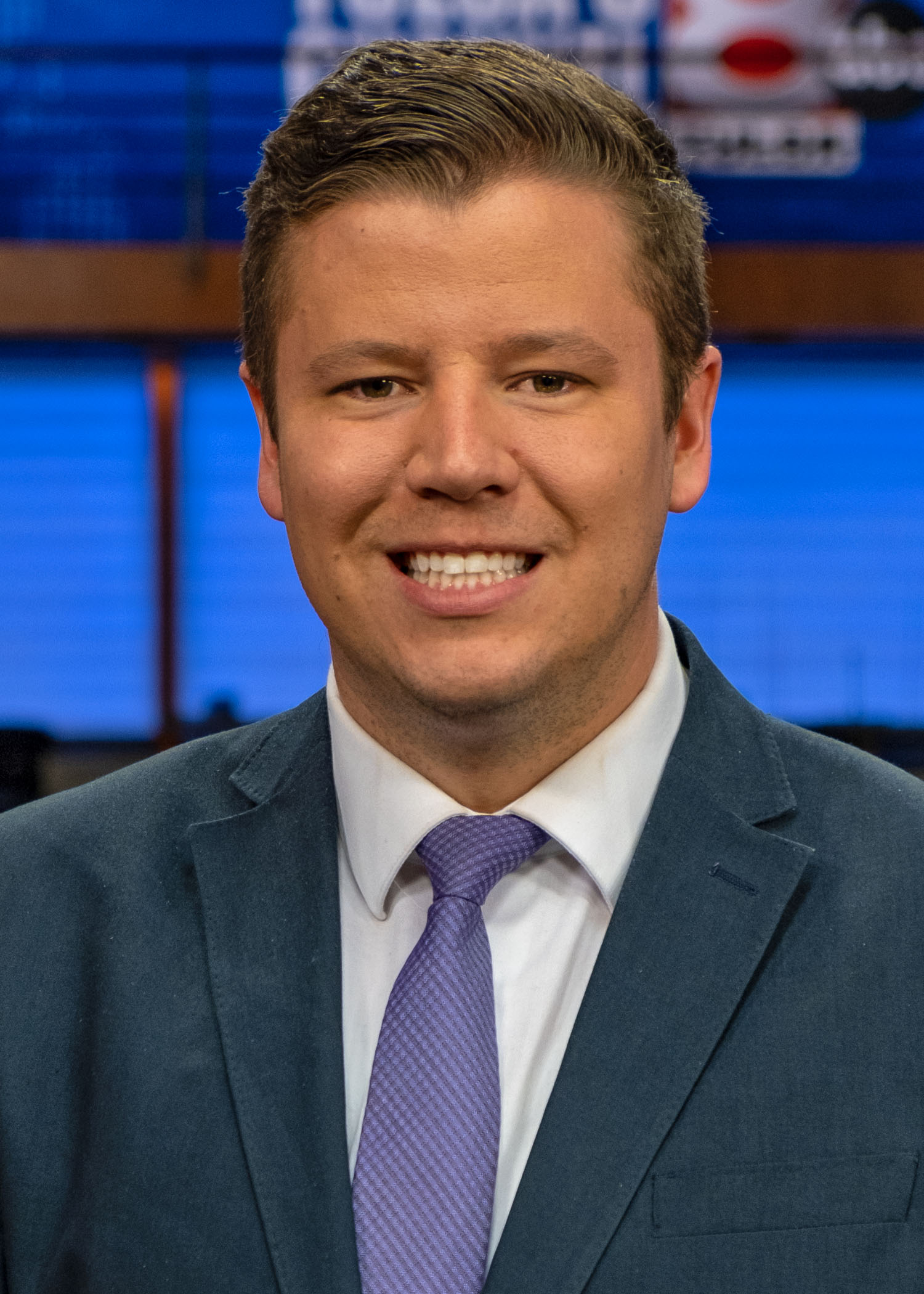 Congratulations also to Chris Nestman, KTUL Channel 8 Meteorologist in Tulsa, Oklahoma, who earned his TV Seal of Approval in June. Good News for Students The application deadline for the 2019 David Freeman NWA Past President's Fund has been extended to July 12, 2019! This fund was established to help students attend the National Weather Association annual meetings. It offsets travel costs up to $1,000, including airfare/transportation, meals, and hotel accommodation for students. The NWA will cover registration fees for the recipients. Dave Freeman has been involved with the NWA for more than two decades and has served on its board for most of those years. He served as the 41st President of the NWA in 2016. This fund honors Dave's work to establish the NWA Foundation and all the past presidents of the NWA. We encourage student members to apply, and others to help promote this outstanding opportunity. More information is available on the NWAF site, as is a link to apply online. Heat Safety Summer is here, bringing with it the usual warm temperatures. Whether the temperatures are normal or extreme, we need to be aware of the dangers high temperatures can bring. Extreme heat and humidity resulting in heat indices over 100 F have already occurred in several parts of the country. Of all weather phenomena, heat is the number one killer. According to Weather Ready Nation, heat causes “hundreds of fatalities each year and even more heat-related illnesses.” The 1995 Chicago heat wave, described in another article in this newsletter, resulted in over 700 deaths in five days. The 2003 European heat wave caused deaths in the tens of thousands (estimates vary between 30,000 to over 70,000). Heat may not be as exciting as tornadoes, lightning, or hurricanes, but it is a weather element to be understood and respected. Some segments of the population are more at risk of dying or developing a heat-related illness, including adults age 65 and older, those with chronic medical conditions, people who work outside, infants and children, and athletes. And don’t forget your pets. Hot weather is dangerous for them too. The American Red Cross has a list of steps you can take to stay safe when the temperatures soar.
The websites referenced in this article have much more information on the effects of heat, definitions of heat illnesses, and how to treat someone suffering a heat illness. Check them out and share the information with friends and family. Let’s reduce heat fatalities for people and animals by being informed and not taking heat for granted. Help promote a Weather-Ready Nation!
New Articles in the Journal of Operational Meteorology
Three NWA JOM articles have been published in the last month. JOM 2019-4: Colorado Lightning Climatology, by Stephen J. Hodanish, Brandon J. Vogt, and Paul Wolyn. JOM 2019-5: A New Metric to Diagnose Precipitation Distribution in Transitioning Tropical Cyclones, by Ajay Raghavendra and Shawn M. Milrad. JOM 2019-6: Cool Season Small Hail over the West Coast of the United States: Environments, Hazards, and Decision Support, by Jonathan Garner, William Iwasko, Matthew Kidwell, Karleisa Rogacheski, Ryan Aylward, and Jason Anderson. The JOM publishes submissions in four categories: Article, Short Contribution, Images of Note and Commentary. The JOM is a peer-reviewed, all-electronic journal with an international scope, providing authors with the benefits of economical publication costs and rapid publication following acceptance. If you are interested in submitting a paper to the JOM, please go to the website for author information. Thank you to the JOM authors, reviewers and editors for continuing to make JOM a success!
National Weather Association | 3100 Monitor Ave, Suite 123 | Norman OK 73072 | 405.701.5167 Publisher: Janice Bunting, NWA Executive Director ISSN 0271-1044 |
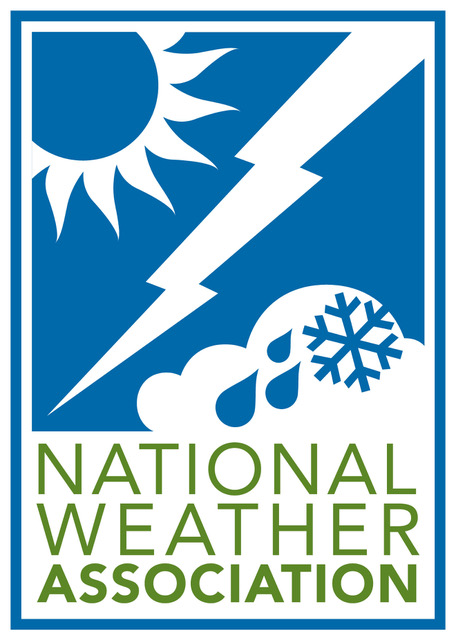
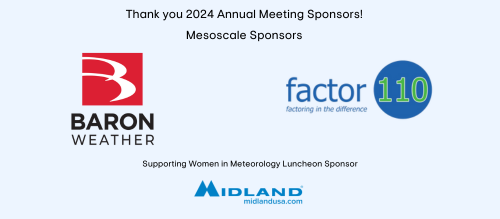
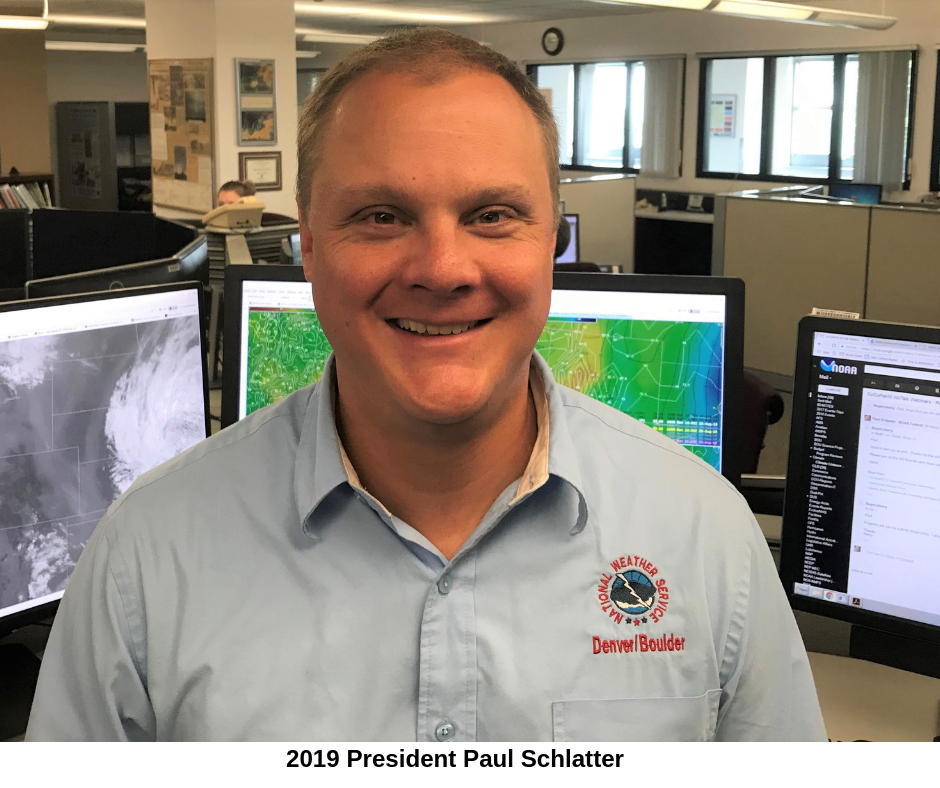
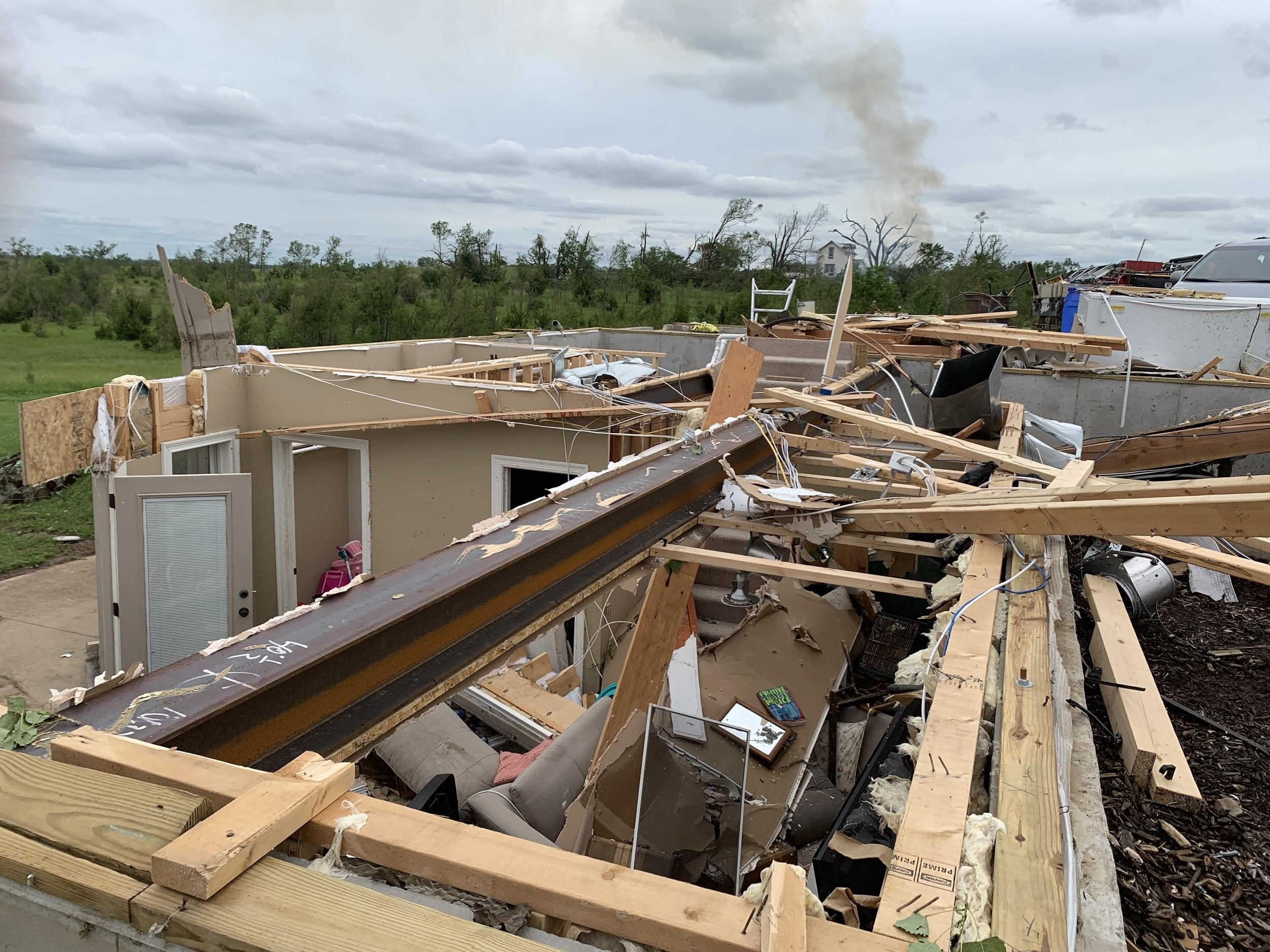
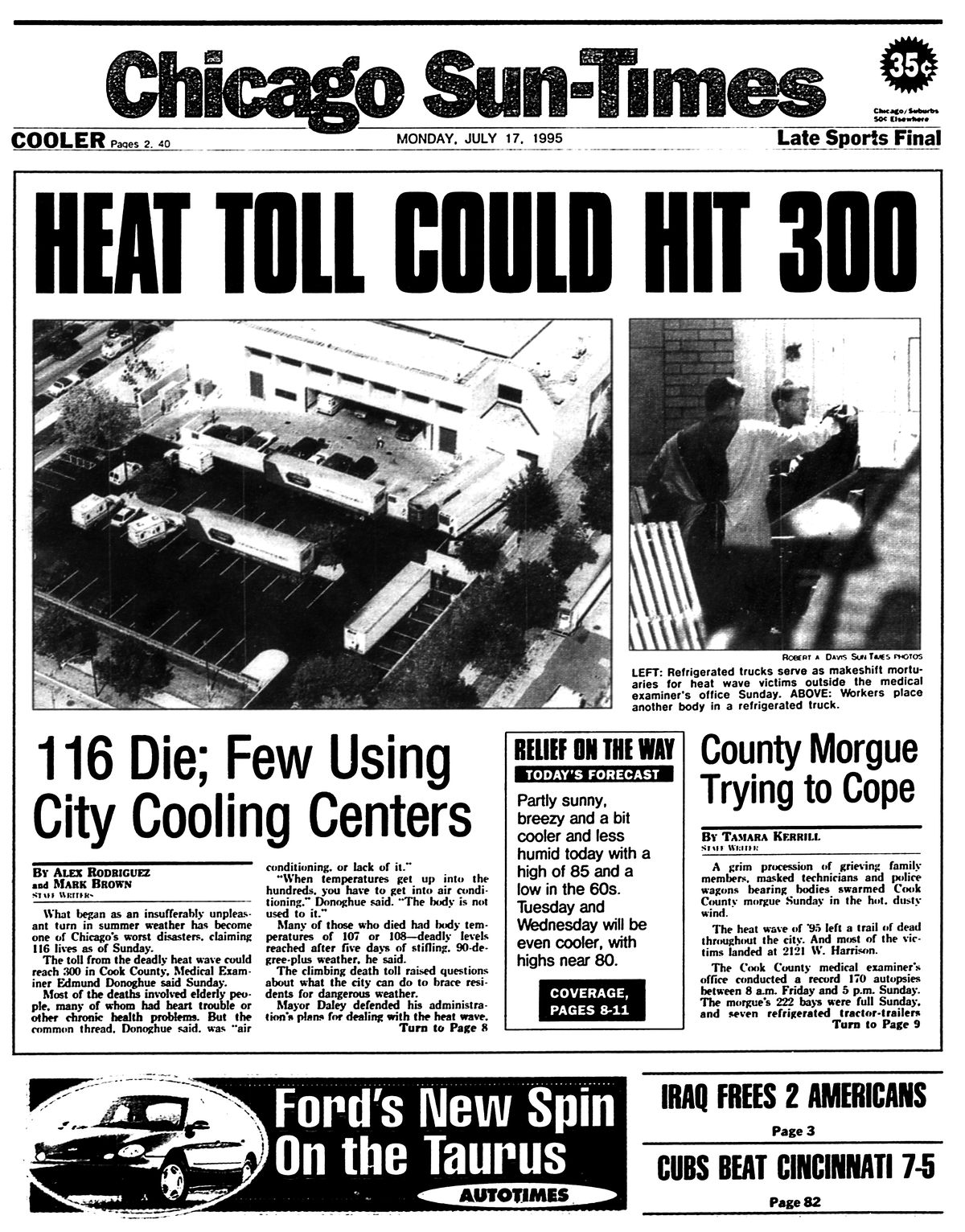
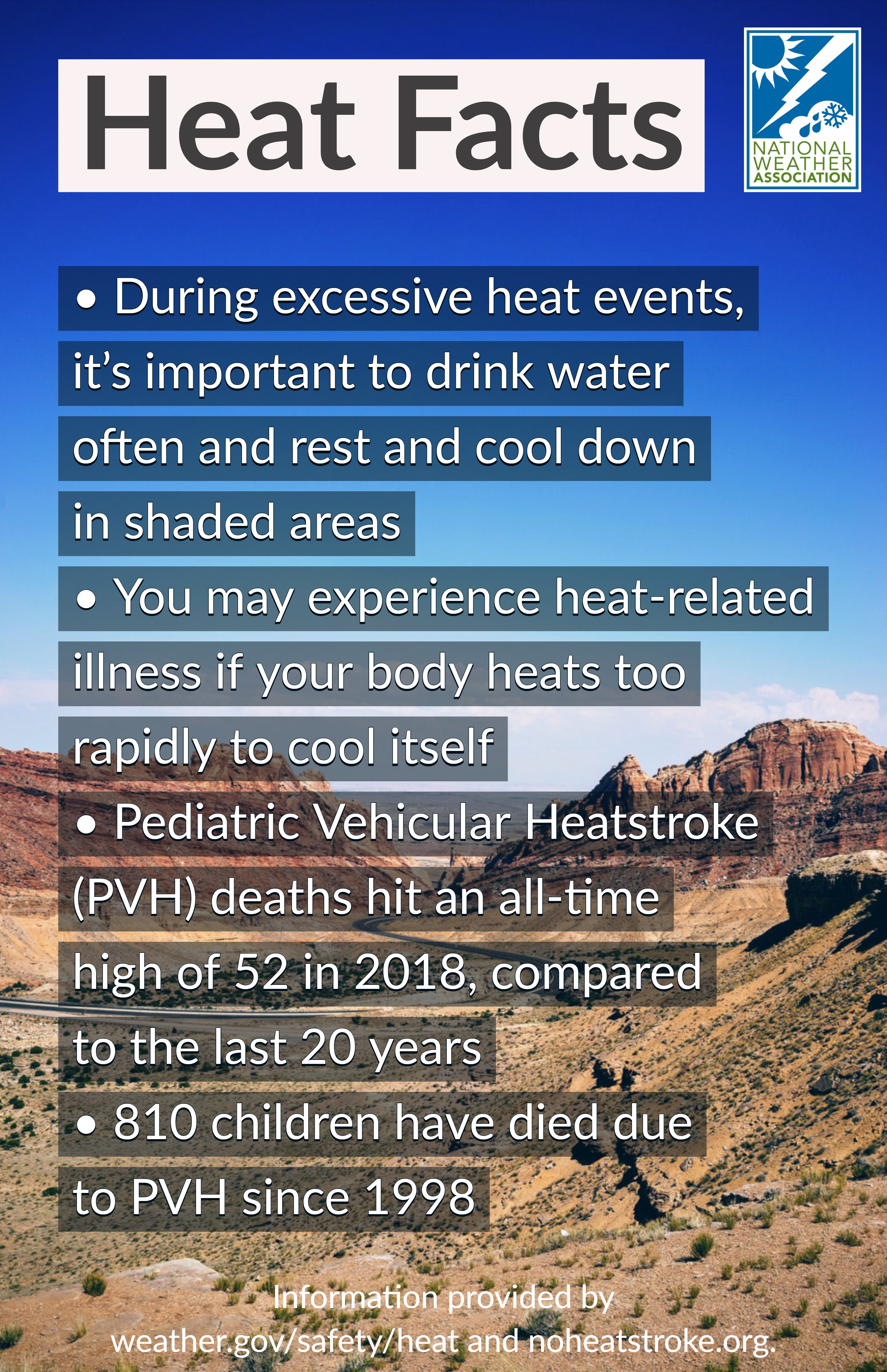
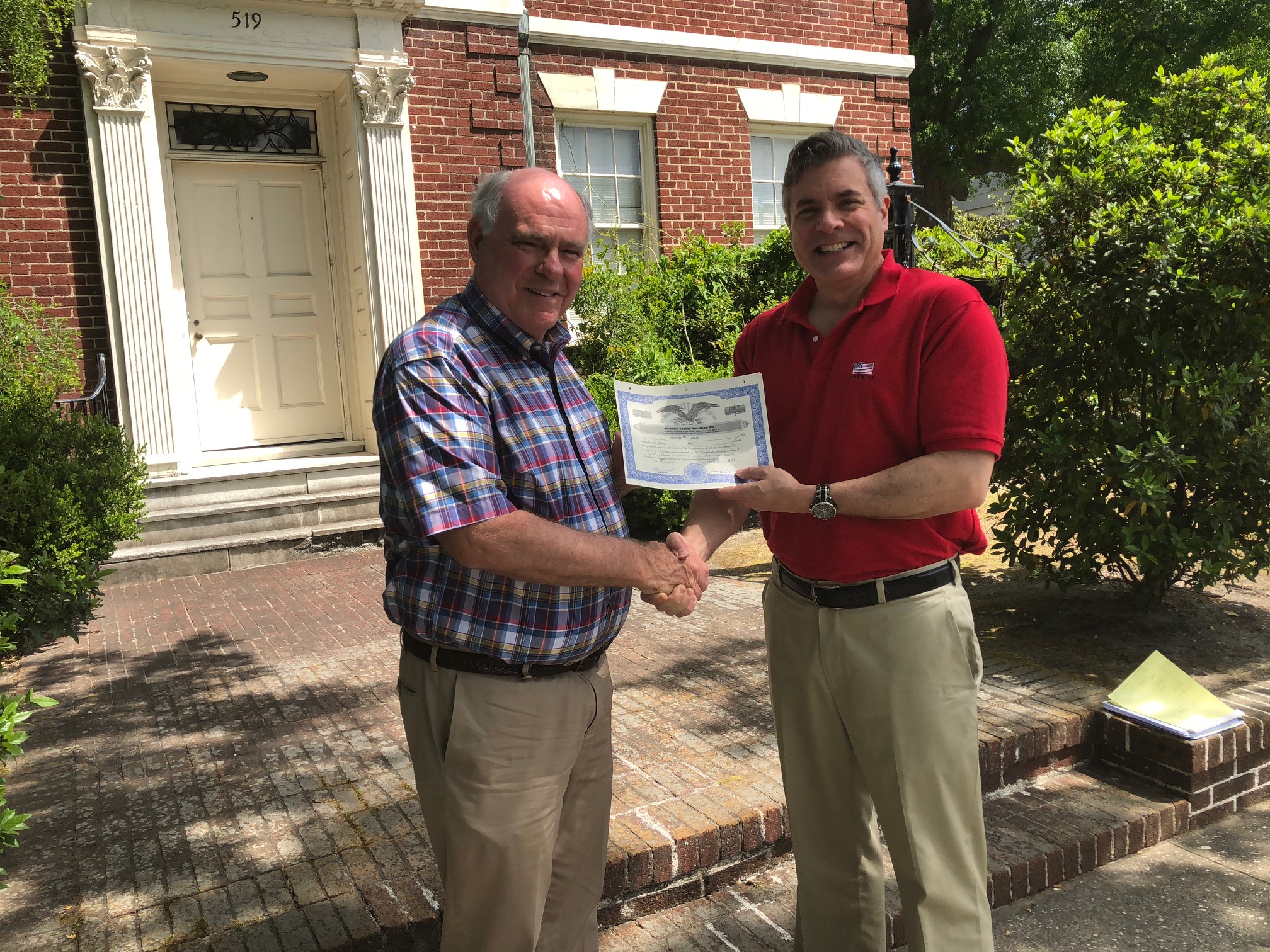 Steve Harned (left) transferring Atlantic States Weather, Inc stock certificates to T.C. Moore (right) in Wilmington, North Carolina, on May 1, 2019.
Steve Harned (left) transferring Atlantic States Weather, Inc stock certificates to T.C. Moore (right) in Wilmington, North Carolina, on May 1, 2019.